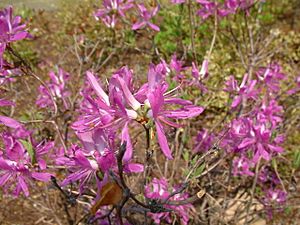Rhodora facts for kids
Quick facts for kids Rhodora |
|
|---|---|
 |
|
| Scientific classification | |
| Kingdom: | |
| (unranked): | |
| (unranked): | |
| (unranked): | |
| Order: | |
| Family: | |
| Genus: | |
| Subgenus: |
Pentanthera
|
| Section: |
Rhodora
|
| Species: |
R. canadense
|
| Binomial name | |
| Rhododendron canadense (L.) Torr.
|
|
| Synonyms | |
|
|
The rhodora (also known as Rhododendron canadense or Canada rosebay) is a beautiful flowering shrub. It loses its leaves in the fall, just like many trees. You can find this plant growing naturally in the northeastern parts of North America.
Contents
What is the Rhodora?
The rhodora is a type of flowering plant. It is a deciduous shrub, meaning it sheds its leaves every year. It grows naturally in the northeastern parts of North America.
Classification
Scientists who study plants, called botanists, think the rhodora is a distant relative of other Rhododendron plants in North America. In the 1800s, some scientists thought the rhodora was so different that they gave it its own group, called Rhodora.
Its closest relative was once thought to be Rhododendron vaseyi. This plant grows in the Appalachian Mountains. However, DNA tests now show that R. vaseyi is not closely related to R. canadense. Instead, R. canadense is more closely related to R. albrechtii.
Description
The rhodora shrub usually grows to be about 0.5 to 1.2 meters (or 1 to 3 feet) tall. In early spring, it produces pretty pinkish-purple flowers. These flowers grow in groups of 2 to 6. Each flower is about 2 to 3 centimeters (or 1 inch) wide.
Flower Structure
The flowers have five petals that form a purple corolla. They are special compared to other rhododendrons in this area. Most rhododendrons have tube-shaped flowers with five stamens (the parts that make pollen). But R. canadense flowers have 10 stamens. These stamens are inside a zygomorphic corolla, which means the flower can only be divided into two equal halves.
Leaves and Seeds
The leaves of the rhodora appear only after the flowers have bloomed and faded. They are narrow and oval-shaped, about 2 to 6 centimeters long and 1 to 2 centimeters wide. Even when it's not flowering, you can spot the rhodora by its unique orange-brown seed cases. These cases are about 1 to 1.2 centimeters long.
Distribution and Habitat
You can find the rhodora growing in the wild from Newfoundland in eastern Canada, all the way to eastern Ontario. In the United States, it is very common in New England. It also grows naturally in New York, New Jersey, and in the higher parts of the Appalachian Mountains down to Pennsylvania.
The rhodora loves to grow in wet, acidic soils. It often thrives in bogs, swamps, and open areas in woodlands.
Culture
For a long time, the rhodora was seen as a special plant for New England. A famous writer named Ralph Waldo Emerson wrote a poem about it. He lived in Concord, Massachusetts. His poem, "The Rhodora: On Being Asked Whence Is the Flower" (published in 1847), talks about the beauty of the flower.
Emerson's poem suggests that the rhodora's beauty is not just for itself. It also shows how all of creation is connected under God. He ends the poem by telling the rhodora, "The self-same Power that brought me there brought you." Later, a composer named Mary Lynn Lightfoot turned this poem into a song for a women's choir.
The name Rhodora is also used for a scientific journal. This journal belongs to the Harvard-affiliated New England Botanical Club. It is a scientific magazine that publishes articles reviewed by other experts. It focuses on the plants of North America.

